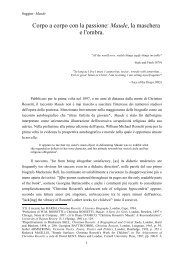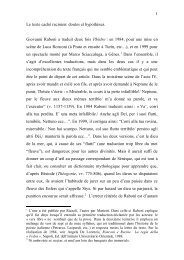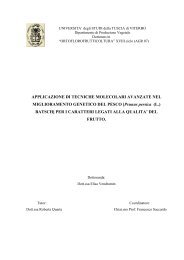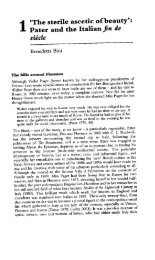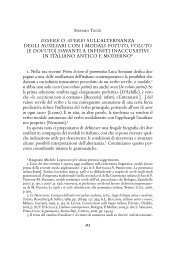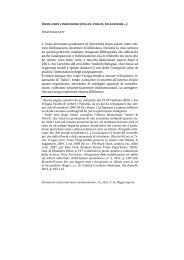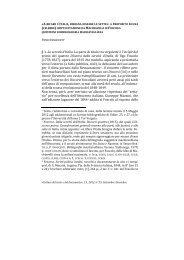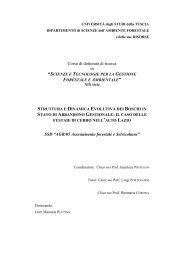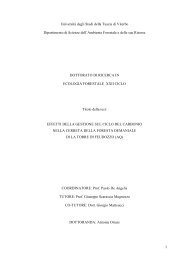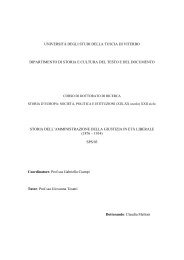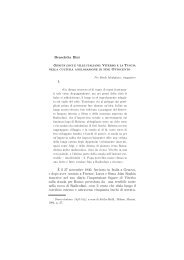drivers of soil respiration of root and microbial ... - Unitus DSpace
drivers of soil respiration of root and microbial ... - Unitus DSpace
drivers of soil respiration of root and microbial ... - Unitus DSpace
You also want an ePaper? Increase the reach of your titles
YUMPU automatically turns print PDFs into web optimized ePapers that Google loves.
oxidation <strong>of</strong> carbohydrates with subsequent evolution <strong>of</strong> CO2 (Aslam <strong>and</strong> Huffacker, 1982;<br />
Ninomyia <strong>and</strong> Sato, 1984).<br />
Depending on the species, the site <strong>of</strong> NO3 - reduction could be located in shoots or <strong>root</strong>s<br />
(Andrews, 1986; Oaks <strong>and</strong> Hirel, 1985; Pate <strong>and</strong> Layzell, 1990; Schilling et.al., 2006; Silveira et al.,<br />
2001; Vuylsteker et al., 1997). By this property, plants are divided into three groups: species<br />
reducing NO3 - predominantly in <strong>root</strong>s, species reducing NO3 - predominantly in shoots, <strong>and</strong> those<br />
that do both. The C costs for reduction <strong>of</strong> NO3 - to NH4 + depend on the site <strong>of</strong> nitrate reduction in<br />
plants.<br />
Nevertheless, the contribution <strong>of</strong> <strong>root</strong>s <strong>and</strong> shoots to whole plant nitrate reduction remains<br />
also uncertain. The location <strong>of</strong> nitrate reduction site seems to be even not species- <strong>and</strong> cultivars-<br />
dependant (Schilling et al., 2006; Silveria et al., 2001), but could vary within a single plant.<br />
Previous studies confirm that environmental conditions, plant growing stage <strong>and</strong> the quantity <strong>of</strong> N<br />
supply could influence <strong>and</strong> change the reduction site location within a plant, although the major part<br />
<strong>of</strong> these findings were done in nutrient solution studies, which do not reflect the real plant uptake<br />
rates, <strong>root</strong> <strong>and</strong> <strong>microbial</strong> <strong>respiration</strong> under true <strong>soil</strong> conditions. It was found that NO3 - translocation<br />
from the <strong>root</strong> to the shoot depends on the N concentration in <strong>soil</strong> solution. At low NO3 -<br />
concentration the reduction occurs mainly in <strong>root</strong>s, at higher concentrations storage <strong>and</strong> then<br />
transport is normally adjusted (Atkins et al. 1979, 1980; Oscarson & Larsson 1986; Agrell, et al.,<br />
1997). The nitrate uptake <strong>and</strong> reductase capacity is not equally distributed along a <strong>root</strong> axis <strong>and</strong> not<br />
identical in <strong>root</strong>s <strong>of</strong> different age <strong>and</strong> ontogeny (Laz<strong>of</strong> et al., 1994; Cruz et al., 1995; Di Laurenzio<br />
et al., 1996). Siebrecht, et al. (1995) <strong>and</strong> Pan et al. (1985) located a high uptake rate together with a<br />
highest reductase activity in the <strong>root</strong> apical region. Older <strong>root</strong> parts were more active in <strong>root</strong> uptake,<br />
but nitrate reductase was low, indicating a possible NO - 3 translocation from these <strong>root</strong> parts to the<br />
shoots. Gojon et al. (1986) have found that <strong>root</strong>s participate actively in the reduction <strong>of</strong> incoming<br />
nitrates during induction process, shortly after the fertilization, after that the <strong>root</strong> contribution<br />
decrease sufficiently.<br />
Based on these results, obtained mainly from the experiments in nutrient solutions, we<br />
hypothesized that the form <strong>of</strong> N nutrition may have a significant effect on the amount <strong>of</strong> CO2<br />
released by <strong>root</strong> <strong>respiration</strong> under true <strong>soil</strong> conditions. Additionally, we expected that the effect <strong>of</strong><br />
the form <strong>of</strong> N nutrition may change between the species with different location <strong>of</strong> nitrate reduction<br />
site <strong>and</strong> during the growth <strong>of</strong> a single plant.<br />
Summarizing the above findings <strong>and</strong> uncertainties, the aims <strong>of</strong> the study were: a) to evaluate<br />
the effect <strong>of</strong> N form (NO3 - vs. NH4 + ) on CO2 efflux from <strong>soil</strong> <strong>and</strong> <strong>root</strong> respiratory losses for species<br />
with different location <strong>of</strong> nitrate reduction site b) to verify if the relative contribution <strong>of</strong> <strong>root</strong>s to the<br />
whole plant nitrate reduction process remains stable during various growing stages <strong>of</strong> a single<br />
123




